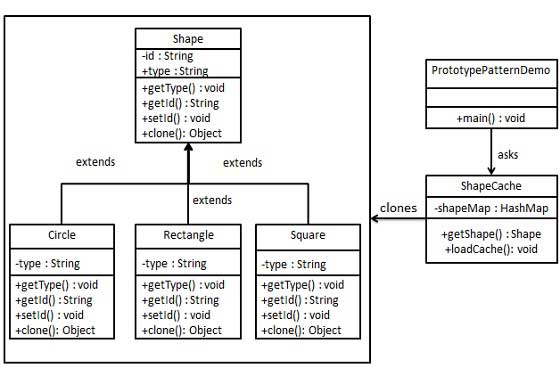設計模式篇之原型模式
阿新 • • 發佈:2018-12-14
原型模式(Prototype Pattern)是用於建立重複的物件,同時又能保證效能。這種型別的設計模式屬於建立型模式,它提供了一種建立物件的最佳方式。
這種模式是實現了一個原型介面,該介面用於建立當前物件的克隆。當直接建立物件的代價比較大時,則採用這種模式。例如,一個物件需要在一個高代價的資料庫操作之後被建立。我們可以快取該物件,在下一個請求時返回它的克隆,在需要的時候更新資料庫,以此來減少資料庫呼叫。
在實際專案中,原型模式很少單獨出現,一般是和工廠方法模式一起出現,通過 clone 的方法建立一個物件,然後由工廠方法提供給呼叫者。原型模式已經與 Java 融為渾然一體,大家可以隨手拿來使用。

//步驟 1 //建立一個實現了 Clonable 介面的抽象類。 Shape.java public abstract class Shape implements Cloneable { private String id; protected String type; abstract void draw(); public String getType(){ return type; } public String getId() { return id; } public void setId(String id) { this.id = id; } public Object clone() { Object clone = null; try { clone = super.clone(); } catch (CloneNotSupportedException e) { e.printStackTrace(); } return clone; } } //步驟 2 //建立擴充套件了上面抽象類的實體類。 Rectangle.java public class Rectangle extends Shape { public Rectangle(){ type = "Rectangle"; } @Override public void draw() { System.out.println("Inside Rectangle::draw() method."); } } Square.java public class Square extends Shape { public Square(){ type = "Square"; } @Override public void draw() { System.out.println("Inside Square::draw() method."); } } Circle.java public class Circle extends Shape { public Circle(){ type = "Circle"; } @Override public void draw() { System.out.println("Inside Circle::draw() method."); } } //步驟 3 //建立一個類,從資料庫獲取實體類,並把它們儲存在一個 Hashtable 中。 ShapeCache.java import java.util.Hashtable; public class ShapeCache { private static Hashtable<String, Shape> shapeMap = new Hashtable<String, Shape>(); public static Shape getShape(String shapeId) { Shape cachedShape = shapeMap.get(shapeId); return (Shape) cachedShape.clone(); } // 對每種形狀都執行資料庫查詢,並建立該形狀 // shapeMap.put(shapeKey, shape); // 例如,我們要新增三種形狀 public static void loadCache() { Circle circle = new Circle(); circle.setId("1"); shapeMap.put(circle.getId(),circle); Square square = new Square(); square.setId("2"); shapeMap.put(square.getId(),square); Rectangle rectangle = new Rectangle(); rectangle.setId("3"); shapeMap.put(rectangle.getId(),rectangle); } } //步驟 4 //PrototypePatternDemo 使用 ShapeCache 類來獲取儲存在 Hashtable 中的形狀的克隆。 PrototypePatternDemo.java public class PrototypePatternDemo { public static void main(String[] args) { ShapeCache.loadCache(); Shape clonedShape = (Shape) ShapeCache.getShape("1"); System.out.println("Shape : " + clonedShape.getType()); Shape clonedShape2 = (Shape) ShapeCache.getShape("2"); System.out.println("Shape : " + clonedShape2.getType()); Shape clonedShape3 = (Shape) ShapeCache.getShape("3"); System.out.println("Shape : " + clonedShape3.getType()); } }
區別其實是在於值傳遞和引用傳遞的區別,當然還有一個特殊的型別String和常量池扯上關係,然後想要做到淺拷貝當然就要重寫clone方法了,如果要深拷貝就要重寫類中類的clone方法,並在本類clone方法中用類中類的clone方法賦值即完成了深拷貝。
完成深拷貝的另一種簡單的方法就是物件序列化了,當然牽扯到的是io流又會有其他的問題了,怎麼選擇當然看自己的目的和需求嘍。
